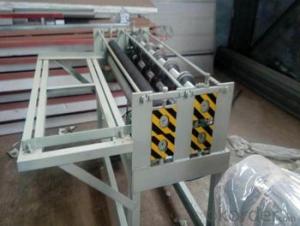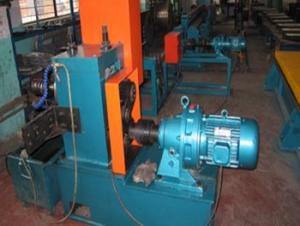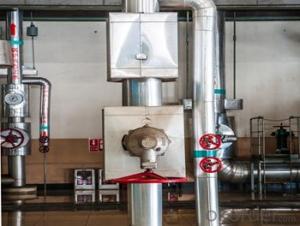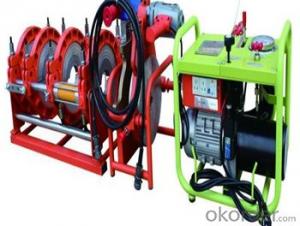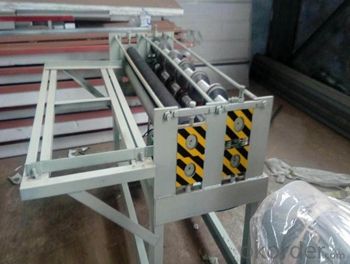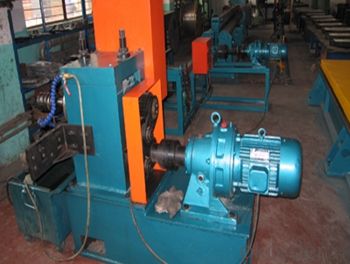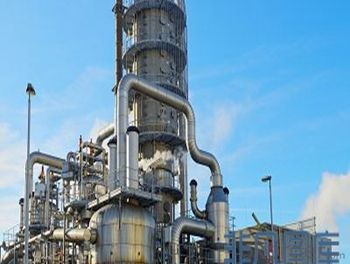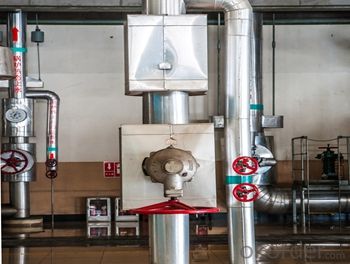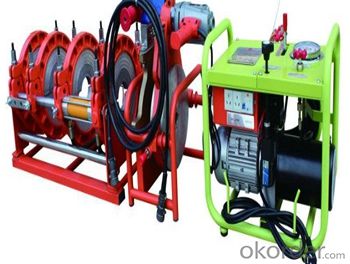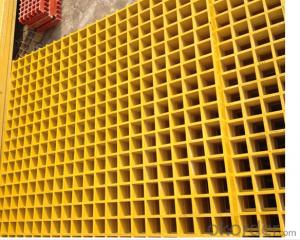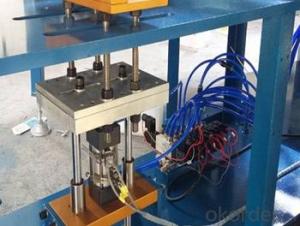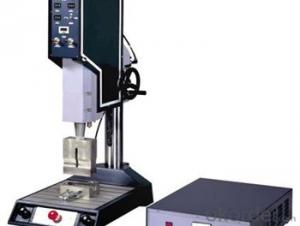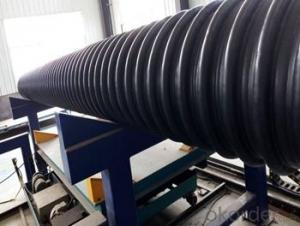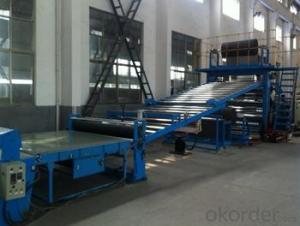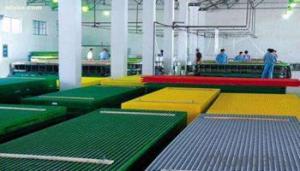FRP Pultrusion Profiles - Non-Toxic High Strength FRP Pultruded Grating
- Loading Port:
- Tianjin
- Payment Terms:
- TT OR LC
- Min Order Qty:
- 2 m.t.
- Supply Capability:
- 50000 m.t./month
OKorder Service Pledge
OKorder Financial Service
You Might Also Like
FRP PULTRUDED GRATING AND PULTRUSION PROCESS
PRODUCT DESCRIPTION
Pultruded grating is made by a particular assembly process, which using “I” shape as its main load-bearing and special rod to go through the bearing bar. Pultruded grating include the standard grating and the custom grating, the custom grating can be designed to meet customer’s requirement or special using condition by changing the shape, size and space of the bearing bars, the surface can be covered with lozenge panel, grit panel, or added the anti-slippery sand directly.
FRP pultruded grating has the most characteristics of molded grating, but it has its distinct advantages, it has very high fiberglass content in the loading direction, so it has very high load capability, it has more superiority when used at wide span, so that the basic support will be decreased and the project cost will be reduced accordingly.
SPECIFICATION
The standard space between two crossbars is 6 inch or 12 inch.
Thickness (mm) | Bar width (mm) | Open space (mm) | Open rate (%) | Approx weight (kg/m |
25.4 | 15.2 | 22.8 | 60 | 13.2 |
25.4 | 15.2 | 15.2 | 50 | 15.9 |
25.4 | 15.2 | 10.1 | 40 | 18.5 |
25.4 | 40 | 10.8 | 21 | 14.5 |
38.1 | 15.2 | 22.8 | 60 | 15.8 |
38.1 | 15.2 | 15.2 | 50 | 19.1 |
38.1 | 15.2 | 10.1 | 40 | 22.4 |
50.8 | 25.4 | 25.4 | 50 | 16.6 |
50.8 | 25.4 | 12.7 | 33 | 21.1 |
CHOICE FOR PULTRUDED GRATING
Resin: GP resin, ISO resin, VE resin, Phenol resin
Color choice: Yellow, gray, green, custom color
Surface choice: Groove surface, grit surface, lozenge cover surface
FEATURES
a. Anti-corrosion and anti-rust
b. Light weight and high strength
c. Anti-flammable
d. Anti- fatigue
e. Safe and anti-slippery
f. Anti-ageing
g. Easy of maintenance
h. Excellent electromagnetism property
i. Good economic benefit
APPLICATION
Operation terrace,
stair walkway,
ground floor,
trench cover,
sidewalk,
foot bridge,
equipment safety fence,
scaffold.
COMPANT DESCRIPTION
CNBM,China National Building Materials Group is a state-owned enterprise in charge of administrative affairs in china building materials industry. Established in 1984, CNBM is a large group corporation of building materials with total assets of 25 billion RMB and a total staff of 30,000.CNBM now owns 200 subordinating firms of solely owned and joint-venture companies.
CNBM International Corporation is one subsidiary of CNBM, we focus on offering good-quality products,professional service and complete solution to our customers. Strong delivery capacity, advanced technology& management, strong financing capability and excellent after-sale service are our advantages in sharing international market.
FAQ
1.Q:Are you factory or trading company ?
A:We are Factory produce FRP machines and FRP products.
2.Q:If can customized by customers requirements?
A:yes,we can produce the machine with customized size.
3.Q:How about the payment?
A:We accept any kind of payment.
4.Q:What is the guarantee?
A:Gurantee is one year.
5.Q:If you can training?
A:yes ,we can training in our factory also can send engineers to your factory training.
PICTURES
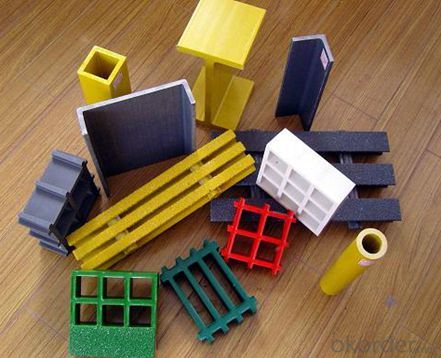
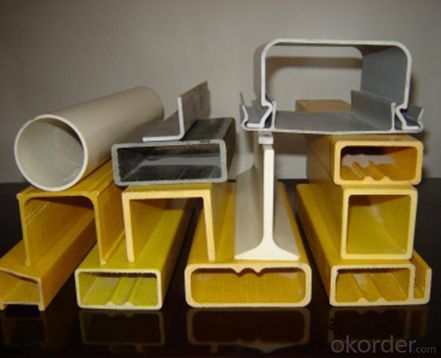
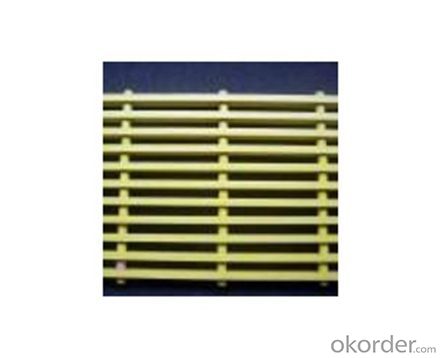
- Q: Can FRP pultrusion profiles be used in the aerospace industry?
- Yes, FRP (Fiber Reinforced Polymer) pultrusion profiles can be used in the aerospace industry. These profiles offer numerous advantages such as high strength-to-weight ratio, corrosion resistance, and design flexibility. They can be used in various aerospace applications including structural components, interior parts, and electrical systems. Additionally, their non-conductive properties make them suitable for applications where electrical insulation is required.
- Q: Can FRP pultrusion profiles be used in the construction of solar panel frames?
- Yes, FRP (Fiber Reinforced Polymer) pultrusion profiles can be used in the construction of solar panel frames. FRP pultrusion profiles are lightweight, strong, and resistant to corrosion, making them an ideal material choice for solar panel frames. The durability and high strength-to-weight ratio of FRP pultrusion profiles ensure that the frames can withstand various weather conditions and long-term exposure to sunlight. Additionally, FRP pultrusion profiles can be easily customized to meet specific design requirements, allowing for flexibility in the construction of solar panel frames. Overall, the use of FRP pultrusion profiles in solar panel frame construction offers numerous advantages, making it a suitable choice for the solar energy industry.
- Q: How to install GRP mark pile
- The possibility of theft (because of the pultruded glass steel material is square or triangle pipe is hollow know who stole 1. useless also know this thing is not plastic can not sell 2. take home cushion not after all not solid no component)
- Q: How do FRP pultrusion profiles perform in high-traffic areas?
- FRP pultrusion profiles are an excellent choice for high-traffic areas due to their exceptional performance characteristics. These profiles are made of reinforced fiberglass and resin, resulting in a highly durable material that can withstand heavy loads and constant foot traffic. One of the key advantages of FRP pultrusion profiles is their high strength-to-weight ratio. This makes them lightweight yet incredibly strong, allowing them to handle heavy loads without sacrificing their structural integrity. Additionally, their non-corrosive nature makes them ideal for areas with high foot traffic, where exposure to moisture, chemicals, and other corrosive elements is common. FRP pultrusion profiles also possess excellent resistance to wear and abrasion. This means that even in high-traffic areas, where constant footfalls and movement can cause conventional materials to deteriorate quickly, FRP profiles remain unaffected, maintaining their original appearance and functionality for an extended period. Furthermore, these profiles are highly resistant to UV radiation, which means they do not degrade or fade when exposed to sunlight. This is particularly important for high-traffic areas that are outdoors or have large windows, as the profiles will maintain their strength and aesthetics even under constant exposure to the sun. In terms of maintenance, FRP pultrusion profiles require minimal upkeep. They do not require regular painting or sealing, as their color and finish are built into the material itself. This significantly reduces maintenance costs and efforts, making them a cost-effective choice for high-traffic areas. Overall, FRP pultrusion profiles are an excellent option for high-traffic areas due to their exceptional strength, durability, resistance to wear and abrasion, non-corrosive properties, UV resistance, and low maintenance requirements. Their ability to withstand heavy loads and constant foot traffic ensures their long-lasting performance, making them a reliable choice for any high-traffic environment.
- Q: Are FRP pultrusion profiles resistant to fungi and mold?
- FRP pultrusion profiles exhibit a general resistance to fungi and mold. This is attributed to the non-porous qualities of the construction materials, namely fiberglass and epoxy resins. These materials create an inhospitable environment for fungi and mold, thus establishing a high level of resistance against their proliferation and colonization. Moreover, FRP pultrusion profiles possess inherent moisture resistance, adding another deterrent to fungi and mold growth. In contrast to wood and its propensity to absorb moisture, FRP profiles do not retain water, rendering them highly resistant to these concerns. The combination of impermeable materials and moisture resistance make FRP pultrusion profiles an ideal choice for environments necessitating fungi and mold resistance, particularly those with high humidity or dampness. However, it is important to acknowledge that no material is entirely impervious to fungi and mold growth in all circumstances. In extreme conditions characterized by prolonged exposure to substantial levels of moisture and organic matter, there remains a possibility for some fungi and mold to colonize FRP profiles. Nevertheless, when compared to alternative materials, FRP pultrusion profiles offer a significantly superior level of resistance against these challenges.
- Q: Are FRP pultrusion profiles resistant to graffiti?
- FRP pultrusion profiles are generally resistant to graffiti due to their unique characteristics and composition. Pultruded fiberglass reinforced plastic (FRP) profiles are manufactured using a combination of high-strength fibers and a polymer resin matrix, resulting in a highly durable and robust material. One of the key advantages of FRP profiles is their excellent resistance to various forms of corrosion, including chemical, moisture, and UV resistance. These properties make FRP profiles less susceptible to the damaging effects of graffiti. Unlike traditional materials such as wood or metal, FRP pultrusion profiles do not provide a porous surface that allows paint or markers to penetrate and adhere easily. Additionally, FRP profiles are often produced with a smooth and non-porous finish, further deterring the attachment of graffiti. Even if graffiti is applied to the surface, it can be easily removed using non-abrasive cleaning methods without causing any damage to the profile's structural integrity or appearance. However, it is important to note that no material is completely immune to graffiti. Determined vandals may still find ways to leave marks on FRP profiles using specialized graffiti materials or techniques. Nonetheless, the resistance of FRP pultrusion profiles to graffiti is significantly higher compared to many other conventional materials, making them an ideal choice for areas prone to vandalism or graffiti attacks.
- Q: Can FRP pultrusion profiles be used in the oil and gas industry?
- Yes, FRP (Fiber Reinforced Polymer) pultrusion profiles can be used in the oil and gas industry. These profiles offer excellent corrosion resistance, high strength-to-weight ratio, and low maintenance requirements, making them suitable for various applications in the industry such as pipe supports, cable trays, handrails, and platforms. Additionally, FRP pultrusion profiles are non-conductive, non-magnetic, and possess good fire-retardant properties, making them a safer alternative to traditional materials in hazardous environments.
- Q: Are FRP pultrusion profiles resistant to nitric acid?
- FRP pultrusion profiles exhibit a general resistance to nitric acid. Nitric acid, being a potent oxidizing agent, has the ability to corrode various materials, including metals. However, the construction of FRP pultrusion profiles involves the use of composite materials that are specifically engineered to withstand the effects of corrosive substances, including nitric acid. The resilience of FRP pultrusion profiles against corrosion is attributed to the combination of reinforcing fibers, such as fiberglass or carbon fiber, and a resin matrix that securely binds these fibers together. The resin matrix, typically a thermosetting polymer like polyester or epoxy, forms a protective barrier that shields the profiles from corrosive substances. Nitric acid is renowned for its capacity to corrode and deteriorate metals. Nonetheless, FRP pultrusion profiles exhibit exceptional resistance to nitric acid due to the inert nature of the composite materials employed. The reinforcing fibers utilized in FRP profiles do not react with nitric acid, while the resin matrix effectively prevents the acid from reaching and corroding the fibers by acting as a barrier. It is essential to acknowledge that the specific resistance of FRP pultrusion profiles to nitric acid may vary depending on the precise composition of the composite materials utilized, as well as the concentration and temperature of the nitric acid. Therefore, it is always advisable to consult the manufacturer or supplier of FRP profiles to ensure their compatibility with nitric acid in specific applications.
- Q: Can FRP pultrusion profiles be used in the construction of railway platforms?
- Indeed, railway platforms can be constructed using FRP (Fiber Reinforced Polymer) pultrusion profiles. These profiles possess numerous advantages that render them suitable for this particular application. To begin with, FRP pultrusion profiles exhibit a combination of lightweight and high durability. Consequently, they are well-suited for railway platforms as they can withstand heavy loads and frequent foot traffic without experiencing significant deformation or degradation over time. Moreover, FRP pultruded profiles boast exceptional corrosion resistance. This feature is particularly crucial for railway platforms, which frequently encounter harsh environmental conditions such as rain, snow, and salt. Unlike traditional materials like steel or wood, FRP does not undergo rust or rot, ensuring a longer lifespan for the platform. Additionally, FRP pultrusion profiles offer versatility in design. They can be customized to meet specific dimensional and structural requirements, facilitating the creation of platforms in various shapes and sizes. This adaptability proves beneficial for railway platforms, which often need to be tailored to fit the available space and accommodate specific railway configurations. Furthermore, FRP pultrusion profiles possess excellent electrical insulation properties. This attribute is vital for railway platforms, as they necessitate electrical isolation from the tracks to prevent electrical shocks and guarantee passenger safety. Lastly, FRP pultrusion profiles are convenient to install and require minimal maintenance. They can be prefabricated off-site and rapidly assembled on-site, thereby reducing construction time and costs. Furthermore, FRP does not demand regular painting or sealing, resulting in time and cost savings in terms of maintenance. In conclusion, due to their lightweight nature, durability, corrosion resistance, design flexibility, electrical insulation properties, and ease of installation and maintenance, FRP pultrusion profiles serve as a viable option for constructing railway platforms.
- Q: Can FRP pultrusion profiles be used in the construction of oil storage tanks?
- FRP pultrusion profiles are a viable option for constructing oil storage tanks due to their numerous benefits. Firstly, the corrosion resistance of FRP is crucial in this application as it ensures the durability of the tanks under harsh environmental conditions and the corrosive properties of oil. Unlike steel, which requires regular maintenance and is prone to corrosion, FRP pultrusion profiles provide a suitable alternative. Moreover, the lightweight nature of FRP pultrusion profiles simplifies their handling and installation compared to heavy steel components. This not only reduces construction time but also cuts down on costs, making FRP an appealing choice for oil storage tank construction. Additionally, FRP pultrusion profiles offer exceptional strength and durability, ensuring the structural integrity of the tanks. The material's impressive strength-to-weight ratio enables efficient load-bearing and structural performance. Furthermore, engineers can customize FRP pultrusion profiles to meet specific design requirements, allowing for flexibility in tank design and construction. The pultrusion process allows for the production of intricate shapes and sizes, enabling engineers to optimize the tank's design for maximum efficiency. Lastly, FRP is non-conductive and possesses high electrical resistance, making it a safe option for oil storage tanks. This eliminates the risk of electrical hazards that may arise in tanks constructed with conductive materials. In conclusion, FRP pultrusion profiles offer a myriad of advantages for constructing oil storage tanks, including corrosion resistance, lightweight construction, high strength, design flexibility, and electrical safety.
Send your message to us
FRP Pultrusion Profiles - Non-Toxic High Strength FRP Pultruded Grating
- Loading Port:
- Tianjin
- Payment Terms:
- TT OR LC
- Min Order Qty:
- 2 m.t.
- Supply Capability:
- 50000 m.t./month
OKorder Service Pledge
OKorder Financial Service
Similar products
Hot products
Hot Searches
Related keywords
